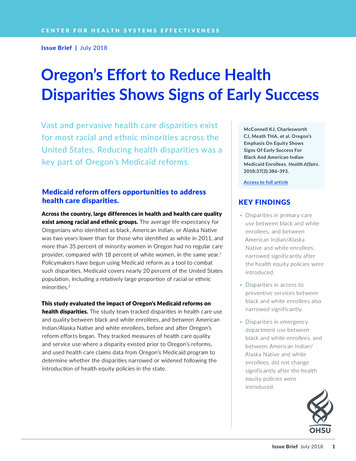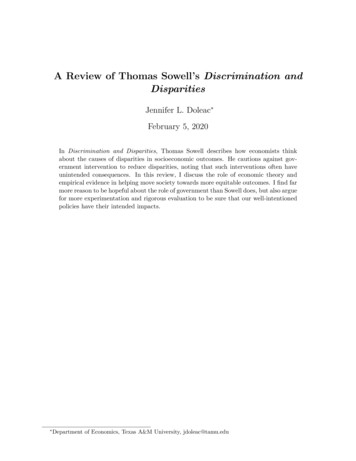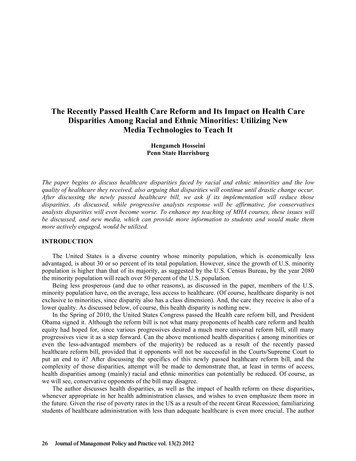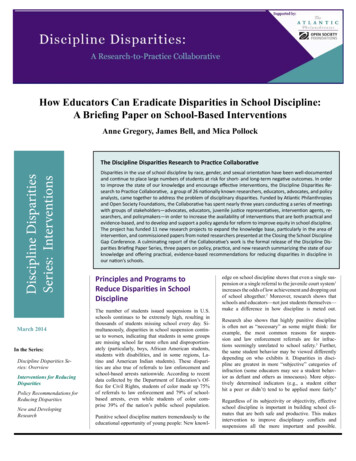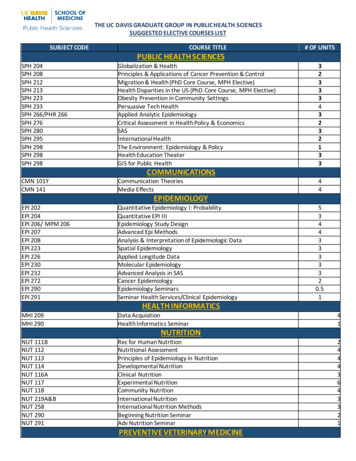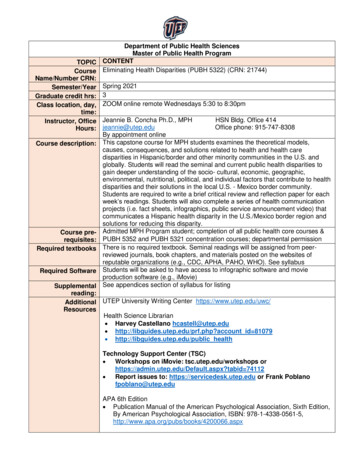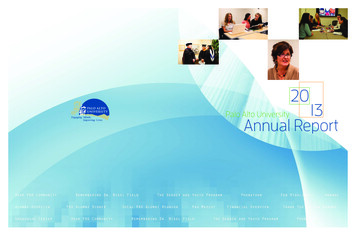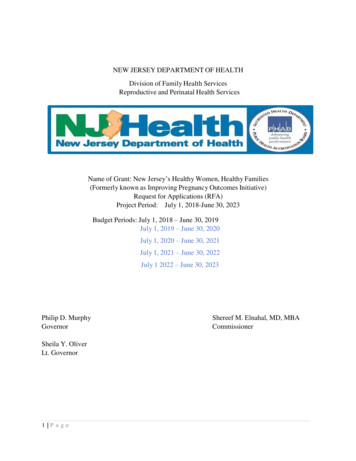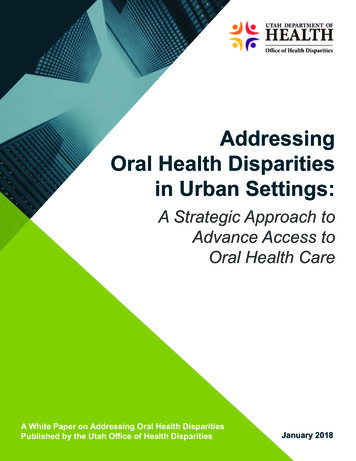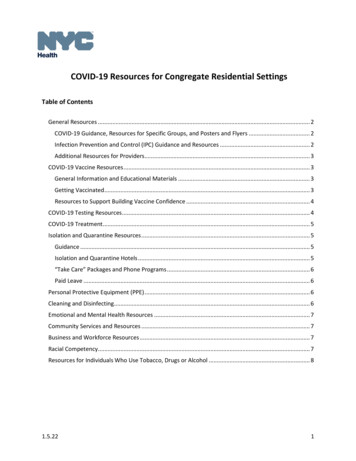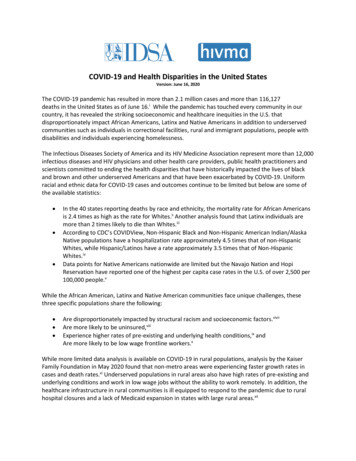
Transcription
COVID-19 and Health Disparities in the United StatesVersion: June 16, 2020The COVID-19 pandemic has resulted in more than 2.1 million cases and more than 116,127deaths in the United States as of June 16.i While the pandemic has touched every community in ourcountry, it has revealed the striking socioeconomic and healthcare inequities in the U.S. thatdisproportionately impact African Americans, Latinx and Native Americans in addition to underservedcommunities such as individuals in correctional facilities, rural and immigrant populations, people withdisabilities and individuals experiencing homelessness.The Infectious Diseases Society of America and its HIV Medicine Association represent more than 12,000infectious diseases and HIV physicians and other health care providers, public health practitioners andscientists committed to ending the health disparities that have historically impacted the lives of blackand brown and other underserved Americans and that have been exacerbated by COVID-19. Uniformracial and ethnic data for COVID-19 cases and outcomes continue to be limited but below are some ofthe available statistics: In the 40 states reporting deaths by race and ethnicity, the mortality rate for African Americansis 2.4 times as high as the rate for Whites.ii Another analysis found that Latinx individuals aremore than 2 times likely to die than Whites.iiiAccording to CDC’s COVIDView, Non-Hispanic Black and Non-Hispanic American Indian/AlaskaNative populations have a hospitalization rate approximately 4.5 times that of non-HispanicWhites, while Hispanic/Latinos have a rate approximately 3.5 times that of Non-HispanicWhites.ivData points for Native Americans nationwide are limited but the Navajo Nation and HopiReservation have reported one of the highest per capita case rates in the U.S. of over 2,500 per100,000 people.vWhile the African American, Latinx and Native American communities face unique challenges, thesethree specific populations share the following: Are disproportionately impacted by structural racism and socioeconomic factors.viviiAre more likely to be uninsured,viiiExperience higher rates of pre-existing and underlying health conditions,ix andAre more likely to be low wage frontline workers.xWhile more limited data analysis is available on COVID-19 in rural populations, analysis by the KaiserFamily Foundation in May 2020 found that non-metro areas were experiencing faster growth rates incases and death rates.xi Underserved populations in rural areas also have high rates of pre-existing andunderlying conditions and work in low wage jobs without the ability to work remotely. In addition, thehealthcare infrastructure in rural communities is ill equipped to respond to the pandemic due to ruralhospital closures and a lack of Medicaid expansion in states with large rural areas.xii
According to the CDC, “people with disabilities may not be inherently at higher risk for COVID-19, butsome people with disabilities may be at higher risk if they have underlying chronic conditions. Adultswith disabilities are three times more likely than adults without disabilities to have heart disease,strokes, diabetes, or cancer.”xiii Additionally, people with disabilities may find wearing masks, selfisolation, and hand-washing challenging without assistance from personal attendants that may not beaccessible because of social distancing measures or staffing shortages. Further, treatment guidelines insome states may explicitly or implicitly deny or limit COVID-19 treatment to people with disabilities.xivThis policy brief and the companion series that will include a brief addressing each populationindividually, highlight issues contributing to the health disparities related to COVID-19 specific to each ofthese unique and vulnerable communities, as well as policy recommendations for addressing them.CALL TO ACTIONPolicy interventions are urgently needed to improve health outcomes and mitigate the impact of COVID19 on African American, Latinx, Native American and other higher risk communities. General policyrecommendations are summarized below but are detailed in the separate policy briefs developed foreach specific population.Improve Access to Healthcare Coverage and Healthcare ServicesThe uninsured rate among African Americans is 1.5 times higher than White Americans and among theLatinx community is 2.5 times higher than White Americans. The uninsured rate among NativeAmericans and Alaskan Natives is the highest of any group at more than 21%.xv Rural populations alsohave higher uninsured rates (12.3%) than mostly urban areas (10.1%).xvi The Medicaid program is alifeline for low income individuals and individuals with chronic conditions. To help address disparitiesand prevent the erosion of Medicaid eligibility and services during this national health crisis, Congressshould: Offer incentives for the 14 states that have not expanded Medicaid to do so.Further increase the federal matching rate for state Medicaid programs to prevent eligibility andcoverage restrictions due to increased demands and strains on state budgets.xviiAuthorize a national special enrollment period for Affordable Care Act plans.Increase funding for safety-net providers, including community health centers and safety-nethospitals including rural hospitals, which are playing a critical role in COVID-19 testing, care andtreatment for the African American and Latinx communitiesxviii and other high risk populationsand communities.Ensure the Collection of COVID-19 Data by Race, Ethnicity, and Disability by Zip CodeHigh quality data on COVID-19 are essential to identify and address disparities and to evaluate andrefine our responses. States should collect and publicly report data in a uniform, rigorous manner. Dataon race, ethnicity, and disability by zip code and institutional and community settings are critical tounderstand and track how specific populations and communities are being impacted by COVID-19 and totarget response efforts.Health department reporting must be uniform across states and include race, ethnicity, and disability byzip code for every COVID-19 case. The reporting of serology or antibody testing must be separate from2
PCR or diagnostic testing and should include the number of tests performed as well as the positivityrate. Uniform reporting that includes race, ethnicity, and disability also should be required forhospitalizations and deaths due to COVID-19. Information regarding testing, cases, and deaths ininstitutional and community settings is important for collecting and reporting accurate data on peoplewith disabilities.xixProvide Access to Affordable, COVID-19 Testing, Prevention, Care and TreatmentAs part of a national COVID-19 testing strategy for COVID-19, testing and contact tracing should beramped up in the communities impacted by COVID-19 and should be easily accessible within thecommunity including at walk up testing sites. Safety-net hospitals including those in rural areas shouldbe prioritized for treatments and clinical trials as they become available.Ensure the availability of masks, hand sanitizer and enhanced educational outreach for communities andpopulations at higher risk for COVID-19.Protections should be in place to ensure that COVID-19 diagnostics, vaccines, and treatment areaffordable, available and accessible in all communities with a focus on communities that havedisproportionately been impacted by COVID-19.The programs created by Congress to support testing, care and treatment for individuals who areuninsured, including the HRSA COVID-19 Reimbursement programxx and the CARES Act Provider Relieffund should be sustained to ensure that individuals have access to the healthcare services they needregardless of their ability to pay.Protect Frontline WorkersCertain racial and ethnic populations, including African Americans, Latinx and Native Americans, areoverrepresented in the lower wage frontline workforce that includes positions in home-health care,grocery stores and food service, public service, transportation, and in the meat packing industry.xxi Dueto the limited ability to social distance in these positions and increased exposure to the public, theseessential workers are at heightened risk for COVID-19. With federal support, we urge companies thatemploy frontline workers be required to provide appropriate personal protective equipment and accessto COVID-19 testing at no charge to employees in addition to providing paid emergency and sick leaveand up to three months of paid family leave. Subsidized childcare also should be available to frontlineline workers.Address Social and Economic Determinants of HealthSignificant structural changes are needed to address the social and economic determinants of healththat are disproportionately harming the well-being of African American, Latinx and Native Americancommunities in addition to other higher risk communities, including rural populations. Over the longterm, systemic changes are needed to promote economic stability, healthy neighborhoods, education,food security and access to culturally competent healthcare in addition to ending structural racismthroughout these systems.xxii In the short-term, the following should be considered: Increase funding for the Federal Communications Commission’s Lifeline program to supportunlimited minutes and Internet access for low income individuals and families to stay connected3
to health care and educational programs.xxiii This is particularly important in sustainingtelehealth access in communities with limited access to healthcare and transportation tohealthcare facilities.Provide a 15% increase in the Supplemental Nutrition Assistance Program maximum benefitlevel to provide additional resources to low income household to purchase food.xxivContinue the moratorium on evictions for failure to pay rent.Increase the availability of housing assistance and temporary housing for individualsexperiencing homeless and those living in shared housing with a large or extended family toquarantine.iJohns Hopkins University. COVID-19 Dashboard by the Center for Systems Science and Engineering (CSSE). Onlineat: l#/bda7594740fd40299423467b48e9ecf6. AccessedJune 16, 2020.iiAPM Research Lab. The Color of Coronavirus: Covid-19 Deaths By Race and Ethnicity in the U.S. Onlineat: e. Accessed June 8, 2020.iiiGross CP, et al. Racial and Ethnic Disparities in Population Level Covid-19 Mortality. medRxiv.doi: ers for Disease Control and Prevention. COVIDView. Ma 23, 2020. Online -data/pdf/covidview-05-29-2020.pdf. Accessed June 3, 2020.vStatista. Navajo Nation Hit Hard by COVID-19. June 3, 2020. Online ricans-covid-impact/. Accessed June 9, 2020.viArtiga S. Health Disparities are a Symptom of Broader Social and Economic Inequities. Kaiser Family Foundation.June 1, 2020. Online at: ities/. Accessed June 9, 2020.viiBailey ZD, Krieger N, Z Agénor M, et al. Structural racism and health inequities in the USA: evidence andinterventions. Lancet 2017; 389: 1453–63.viiiArtiga, S., et al. Changes in Health Coverage by Race and Ethnicity since the ACA, 2010-2018. Kaiser FamilyFoundation. March 5, 2020.ixArtiga S, Garfield R, Orgera K. Communities of Color at Higher Risk for Health and Economic Challenges due toCOVID-19. Kaiser Family Foundation. April 7, 2020. Online at: nd-economic-challenges-due-to-covid-19/. Accessed June 9,2020.xBlau FD, Koebe J, Meyerhofer PA. Essential and Frontline Workers in the COVID-19 Crisis. Econofact. April 30,2020. Online at: ers-in-the-covid-19-crisis. Accessed June 9,2020.xiKFF. COVID-19 in Metropolitan and Non-Metropolitan Counties. May 21, 2020.xiiNational Health Law Program. The COVID-19 Pandemic Will Cause Deep cuts to Rural America. May 20, n-letter-2020-4-27.pdfxvIBID. Artiga, S., et al.xviUnited States Census Bureau. Health Insurance in Rural America. April , MB. Key Questions About the New Increase in Federal Medicaid Matching Funds for COVID-19.KFF. May 4, 2020. Online at: medicaid-matching-funds-for-covid-19/. Accessed June 9, 2020.4
xviiiCorallo B, Tolbert J. Impact of Coronavirus on Community Health Centers. KFF. May 20, 2020. Online nters/. June9, lity-data-collection-letter-2020-4-27.pdfxxHealth Resources and Services Administration. COVID-19 Claims Reimbursement to Health Care Providers andFacilities for Testing and Treatment of the Uninsured. Online at:https://www.hrsa.gov/CovidUninsuredClaim#: :text D19%20diagnosis.&text body%20testing. AccessedJune 8, 2020.xxiIBID. Blau FD, Koebe J, Meyerhofer PA.xxiiIBID. Artiga S. June 1, 2020.xxiiiFCC. Lifeline Program for Low-Income Consumers. Online wincome-consumers. Accessed June 3, 2020.xxivCenter on Budget and Policy Priorities. April 29, 2020. Available at: resources-pay-for5
Improve Access to Healthcare Coverage and Healthcare Services . The uninsured rate among African Americans is 1.5 times higher than White Americans and among the Latinx community is 2.5 times higher than White Americans. The uninsured rate among Native Americans and Alaskan Natives is the highest of any group at more than 21%. xv
